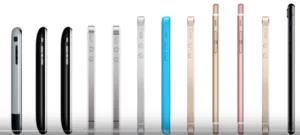It seems to have been a week with a number of anniversaries. I spent a couple of days at Leti in Grenoble this week, as it celebrated 50 years of R&D in microelectronics and semiconductors. However, I felt that I couldn’t write my editorial this week without considering the iPhone, which celebrated ten years this year. I’ve been in the industry a long time and although I focus on the future and the new trends, I do like to look back at times. In the past, for some periods, we have run editorial articles based on what was happening ten or twenty years ago. However, usually I got out-voted on whether these were really interesting, so we haven’t done it for a while!
At the time of the iPhone launch, we weren’t so interested in mobile devices, so we didn’t cover it heavily. We did describe it as “a phone, an MP3 player and a web browser”. It seems that it didn’t look like the integrated and monolithic ‘smartphone’ that it has become at the time. Looking back, we probably should have paid more attention. We didn’t cover apps a lot in the early years, although we certainly recognised that the success of the iPhone was not just in the hardware, as clever as it was, but in the combination with the hardware and with the unleashing of the creativity of app developers. In 2009, two years after the launch, we reported that 1.5 billion app downloads had been done of 65,000 apps from 100,000 developers.
One of the topics that has come up many times since the launch of the iPhone, is the use of touch. Up until the iPhone, touch was an industrial technology with many different versions. No technology was dominant, although resistive was the most widely used. According to industry sources at the time, Apple was paying more for the touch technology in the iPhone, which was based from the start on PCap technology, than it was for the displays themselves. Many thought that Apple was mad.
However, Apple’s strategy was to combine great hardware with a compelling and simple and intuitive user interface (for which the touch performance was critical) and building a platform for developers. That has remained the core of the iPhone experience (as I understand it – I have never owned one!). Of course, the adoption of ‘retina’ displays (2010 – iPhone 4), amazingly good and tiny cameras as well as GPS (2008) pushed things along. It has been argued that GPS only made it because the Japanese government mandated for phones it to help find survivors in the case of a natural disaster, so those that wanted to compete in the Japanese phone market had no choice but to add it to their chips. Siri started in 2011 and fingerprint recognition was added in 2013. Since then, the changes have been small and incremental.
Arguably, with the OLEDs in its Galaxy and Galaxy Edge, Samsung has taken the lead in displays for smartphones. Apple’s displays have been good, as Ray Soneira has pointed out, but not really game changing in recent years.
Anyway, congratulations to Apple for staying at the top for so long. The electronics business became a ‘hits’ business years ago, with a quick demise for anyone that doesn’t do well. That Apple is still at the top is a great achievement.
Bob

